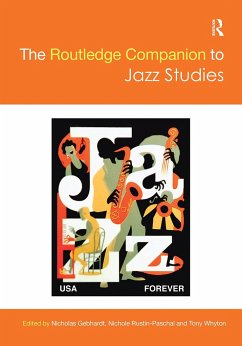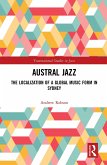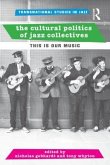The Routledge Companion to Jazz Studies
Herausgeber: Gebhardt, Nicholas; Whyton, Tony; Rustin-Paschal, Nichole
The Routledge Companion to Jazz Studies
Herausgeber: Gebhardt, Nicholas; Whyton, Tony; Rustin-Paschal, Nichole
- Broschiertes Buch
- Merkliste
- Auf die Merkliste
- Bewerten Bewerten
- Teilen
- Produkt teilen
- Produkterinnerung
- Produkterinnerung
The Routledge Companion to Jazz Studies presents over forty commissioned articles from internationally renowned scholars and highlights the strengths of current jazz scholarship in a cross-disciplinary field of enquirey. Each chapter reflects on developments within jazz studies over the last twenty-five years.
Andere Kunden interessierten sich auch für
![The Routledge Companion to Music, Technology, and Education The Routledge Companion to Music, Technology, and Education]() The Routledge Companion to Music, Technology, and Education70,99 €
The Routledge Companion to Music, Technology, and Education70,99 €![Austral Jazz Austral Jazz]() Andrew RobsonAustral Jazz64,99 €
Andrew RobsonAustral Jazz64,99 €![Jazz in Socialist Hà N¿i Jazz in Socialist Hà N¿i]() Stan Bh Tan-TangbauJazz in Socialist Hà N¿i66,99 €
Stan Bh Tan-TangbauJazz in Socialist Hà N¿i66,99 €![The Cultural Politics of Jazz Collectives The Cultural Politics of Jazz Collectives]() The Cultural Politics of Jazz Collectives73,99 €
The Cultural Politics of Jazz Collectives73,99 €![Music, Sexuality and the Enlightenment in Mozart's Figaro, Don Giovanni and Così fan tutte Music, Sexuality and the Enlightenment in Mozart's Figaro, Don Giovanni and Così fan tutte]() Charles FordMusic, Sexuality and the Enlightenment in Mozart's Figaro, Don Giovanni and Così fan tutte72,99 €
Charles FordMusic, Sexuality and the Enlightenment in Mozart's Figaro, Don Giovanni and Così fan tutte72,99 €![Singing the Body Electric Singing the Body Electric]() Miriama YoungSinging the Body Electric66,99 €
Miriama YoungSinging the Body Electric66,99 €![British Women Composers and Instrumental Chamber Music in the Early Twentieth Century. Laura Seddon British Women Composers and Instrumental Chamber Music in the Early Twentieth Century. Laura Seddon]() Laura SeddonBritish Women Composers and Instrumental Chamber Music in the Early Twentieth Century. Laura Seddon76,99 €
Laura SeddonBritish Women Composers and Instrumental Chamber Music in the Early Twentieth Century. Laura Seddon76,99 €-
-
-
The Routledge Companion to Jazz Studies presents over forty commissioned articles from internationally renowned scholars and highlights the strengths of current jazz scholarship in a cross-disciplinary field of enquirey. Each chapter reflects on developments within jazz studies over the last twenty-five years.
Hinweis: Dieser Artikel kann nur an eine deutsche Lieferadresse ausgeliefert werden.
Hinweis: Dieser Artikel kann nur an eine deutsche Lieferadresse ausgeliefert werden.
Produktdetails
- Produktdetails
- Verlag: Routledge
- Seitenzahl: 514
- Erscheinungstermin: 13. Dezember 2021
- Englisch
- Abmessung: 254mm x 178mm x 27mm
- Gewicht: 956g
- ISBN-13: 9781032241715
- ISBN-10: 1032241713
- Artikelnr.: 62951327
- Herstellerkennzeichnung
- Libri GmbH
- Europaallee 1
- 36244 Bad Hersfeld
- gpsr@libri.de
- Verlag: Routledge
- Seitenzahl: 514
- Erscheinungstermin: 13. Dezember 2021
- Englisch
- Abmessung: 254mm x 178mm x 27mm
- Gewicht: 956g
- ISBN-13: 9781032241715
- ISBN-10: 1032241713
- Artikelnr.: 62951327
- Herstellerkennzeichnung
- Libri GmbH
- Europaallee 1
- 36244 Bad Hersfeld
- gpsr@libri.de
Nicholas Gebhardt is Professor of Jazz and Popular Music Studies at Birmingham City University and Director of the Birmingham Centre for Media and Cultural Research. His work focuses on jazz and popular music in American culture, and his publications include Going For Jazz: Musical Practices and American Ideology and Vaudeville Melodies: Popular Musicians and Mass Entertainment in American Culture, 1870-1929. Nichole Rustin-Paschal earned a J.D. from the University of Virginia and a Ph.D. from New York University. She is the author of The Kind of Man I Am: Jazzmasculinity and the World of Charles Mingus Jr. and co-editor with Sherrie Tucker of Big Ears: Listening for Gender in Jazz Studies. Tony Whyton is Professor of Jazz Studies at Birmingham City University and author of Jazz Icons: Heroes, Myths and the Jazz Tradition and Beyond A Love Supreme: John Coltrane and the Legacy of an Album. As an editor, Whyton has worked as the co-editor of the Jazz Research Journal since 2004 and he currently co-edits the Routledge series 'Transnational Studies in Jazz'.
PA RT I: Historical Perspectives 1. Wilkie's Story: Dominant Histories,
Hidden Musicians, and Cosmopolitan Connections in Jazz (Tony Whyton) / 2.
Diasporic Jazz (Bruce Johnson) / 3. I Like to Recognize the Tune:
Interrupting Jazz and Musical Theater Histories (Julianne Lindberg) / 4.
"That Ain't No Creole, It's a . . .!": Masquerade, Marketing, and
Shapeshifting Race in Early New Orleans Jazz (Bruce Boyd Raeburn) / 5. Jazz
Education: Historical and Critical Perspectives (Ken Prouty) / 6. Swan
Songs: Jazz, Death, and Famous Last Concerts (Walter van de Leur) 7. Jazz
on Radio (Tim Wall) PART II: Methodologies 8. After Wynton: Narrating Jazz
in the Postneotraditional Era (David Ake) / 9. Jazz and the Material Turn
(Floris Schuiling) / 10. Jazz Meets Pop in the United Kingdom (Catherine
Tackley) / 11. On Billboard, Isaac Hayes, and the "Swinging Relationship"
Between Jazz and Its Popular Music Cousins, 1950-1973 (John Howland) / 12.
"Wacky Post-Fluxus Revolutionary Mixed Media Shenanigans": Rethinking Jazz
and Jazz Studies Through Jason Moran's Multimedia Performance (John
Gennari) / 13. Conceptualizing Jazz as a Cultural Practice in Soviet
Estonia (Heli Reimann) / 14. And Then I Don't Feel So Bad: Jazz,
Sentimentality, and Popular Song (Alan Stanbridge) PART III: Core Issues
and Topics 15. Space and Place in Jazz (Andrew Berish) / 16. Time in Jazz
(Mark Doffman) / 17. Jazz and Disability (George McKay) / 18. Race in the
New Jazz Studies (Patrick Burke) / 19. The Vocalized Tone (Tom Perchard) /
20. Jazz and the Recording Process (Benjamin Bierman) / 21. Figuring
Improvisation (Peter Elsdon) / 22. Listening for Empire in Transnational
Jazz Studies (Frederick J. Schenker) PART IV: Individuals, Collectives, and
Communities 23. New Orleans, the "Creole Concept," and Jazz (Wolfram
Knauer) / 24. Sitting In and Subbing Out: The Gig Economy of 1960s New York
(Marian Jago) / 25. George Lewis's Voyager (Paul Steinbeck) / 26. Quiet
About It-Jazz in Japan (Michael Pronko) / 27. Performing Improvisation:
Bill Evans and Jean-Yves Thibaudet (Deborah Mawer) / 28. Bossa Nova and
Beyond: The Jazz as Symbol of Brazilian-Ness (Eduardo Vicente) / 29.
Individuals, Collectives, and Communities: Festivals and Festivalization:
The Shaping Influence of a Jazz Institution (Scott Currie) PART V:
Politics, Discourse, and Ideology 30. The Birth of Jazz Diplomacy: American
Jazz in Italy, 1945-1963 (Anna Harwell Celenza) / 31. Jazzing for a Better
Future: South Africa and Beyond (Christopher Ballantine) / 32. Eric
Hobsbawm (Roger Fagge) / 33. Jazz at the Crossroads of Art and Popular
Music Discourses in the 1960s (David Brackett) / 34. The Rhetoric of Jazz
(Gregory Clark) / 35. Unfinalizable: Dialog and Self-Expression in Jazz
(Charles Hersch) / 36. Improvisation: What Is It Good for? (Raymond
MacDonald and Graeme Wilson) / 37. Friends and Neighbors: Jazz and Everyday
Aesthetics (Nicholas Gebhardt) PART VI: New Directions and Debates 38. "The
Reason I Play the Way I Do Is": Jazzmen, Emotion, and Creating in Jazz
(Nichole Rustin-Paschal) / 39. The Art of Improvisation in the Age of
Computational Participation (David Borgo) / 40. Renaissance or Afterlife?
Nostalgia in the New Jazz Films (Björn Heile) / 41. Comics as Criticism:
Harvey Pekar, Jazz Writer (Nicolas Pillai) / 42. Free Spirits: The
Performativity of Free Improvisation (Petter Frost Fadnes) / 43. My Jazz
World: The Rise and Fall of a Digital Utopia (Simon Barber) / 44. Writing
the Jazz Life (Krin Gabbard)
Hidden Musicians, and Cosmopolitan Connections in Jazz (Tony Whyton) / 2.
Diasporic Jazz (Bruce Johnson) / 3. I Like to Recognize the Tune:
Interrupting Jazz and Musical Theater Histories (Julianne Lindberg) / 4.
"That Ain't No Creole, It's a . . .!": Masquerade, Marketing, and
Shapeshifting Race in Early New Orleans Jazz (Bruce Boyd Raeburn) / 5. Jazz
Education: Historical and Critical Perspectives (Ken Prouty) / 6. Swan
Songs: Jazz, Death, and Famous Last Concerts (Walter van de Leur) 7. Jazz
on Radio (Tim Wall) PART II: Methodologies 8. After Wynton: Narrating Jazz
in the Postneotraditional Era (David Ake) / 9. Jazz and the Material Turn
(Floris Schuiling) / 10. Jazz Meets Pop in the United Kingdom (Catherine
Tackley) / 11. On Billboard, Isaac Hayes, and the "Swinging Relationship"
Between Jazz and Its Popular Music Cousins, 1950-1973 (John Howland) / 12.
"Wacky Post-Fluxus Revolutionary Mixed Media Shenanigans": Rethinking Jazz
and Jazz Studies Through Jason Moran's Multimedia Performance (John
Gennari) / 13. Conceptualizing Jazz as a Cultural Practice in Soviet
Estonia (Heli Reimann) / 14. And Then I Don't Feel So Bad: Jazz,
Sentimentality, and Popular Song (Alan Stanbridge) PART III: Core Issues
and Topics 15. Space and Place in Jazz (Andrew Berish) / 16. Time in Jazz
(Mark Doffman) / 17. Jazz and Disability (George McKay) / 18. Race in the
New Jazz Studies (Patrick Burke) / 19. The Vocalized Tone (Tom Perchard) /
20. Jazz and the Recording Process (Benjamin Bierman) / 21. Figuring
Improvisation (Peter Elsdon) / 22. Listening for Empire in Transnational
Jazz Studies (Frederick J. Schenker) PART IV: Individuals, Collectives, and
Communities 23. New Orleans, the "Creole Concept," and Jazz (Wolfram
Knauer) / 24. Sitting In and Subbing Out: The Gig Economy of 1960s New York
(Marian Jago) / 25. George Lewis's Voyager (Paul Steinbeck) / 26. Quiet
About It-Jazz in Japan (Michael Pronko) / 27. Performing Improvisation:
Bill Evans and Jean-Yves Thibaudet (Deborah Mawer) / 28. Bossa Nova and
Beyond: The Jazz as Symbol of Brazilian-Ness (Eduardo Vicente) / 29.
Individuals, Collectives, and Communities: Festivals and Festivalization:
The Shaping Influence of a Jazz Institution (Scott Currie) PART V:
Politics, Discourse, and Ideology 30. The Birth of Jazz Diplomacy: American
Jazz in Italy, 1945-1963 (Anna Harwell Celenza) / 31. Jazzing for a Better
Future: South Africa and Beyond (Christopher Ballantine) / 32. Eric
Hobsbawm (Roger Fagge) / 33. Jazz at the Crossroads of Art and Popular
Music Discourses in the 1960s (David Brackett) / 34. The Rhetoric of Jazz
(Gregory Clark) / 35. Unfinalizable: Dialog and Self-Expression in Jazz
(Charles Hersch) / 36. Improvisation: What Is It Good for? (Raymond
MacDonald and Graeme Wilson) / 37. Friends and Neighbors: Jazz and Everyday
Aesthetics (Nicholas Gebhardt) PART VI: New Directions and Debates 38. "The
Reason I Play the Way I Do Is": Jazzmen, Emotion, and Creating in Jazz
(Nichole Rustin-Paschal) / 39. The Art of Improvisation in the Age of
Computational Participation (David Borgo) / 40. Renaissance or Afterlife?
Nostalgia in the New Jazz Films (Björn Heile) / 41. Comics as Criticism:
Harvey Pekar, Jazz Writer (Nicolas Pillai) / 42. Free Spirits: The
Performativity of Free Improvisation (Petter Frost Fadnes) / 43. My Jazz
World: The Rise and Fall of a Digital Utopia (Simon Barber) / 44. Writing
the Jazz Life (Krin Gabbard)
PA RT I: Historical Perspectives 1. Wilkie's Story: Dominant Histories,
Hidden Musicians, and Cosmopolitan Connections in Jazz (Tony Whyton) / 2.
Diasporic Jazz (Bruce Johnson) / 3. I Like to Recognize the Tune:
Interrupting Jazz and Musical Theater Histories (Julianne Lindberg) / 4.
"That Ain't No Creole, It's a . . .!": Masquerade, Marketing, and
Shapeshifting Race in Early New Orleans Jazz (Bruce Boyd Raeburn) / 5. Jazz
Education: Historical and Critical Perspectives (Ken Prouty) / 6. Swan
Songs: Jazz, Death, and Famous Last Concerts (Walter van de Leur) 7. Jazz
on Radio (Tim Wall) PART II: Methodologies 8. After Wynton: Narrating Jazz
in the Postneotraditional Era (David Ake) / 9. Jazz and the Material Turn
(Floris Schuiling) / 10. Jazz Meets Pop in the United Kingdom (Catherine
Tackley) / 11. On Billboard, Isaac Hayes, and the "Swinging Relationship"
Between Jazz and Its Popular Music Cousins, 1950-1973 (John Howland) / 12.
"Wacky Post-Fluxus Revolutionary Mixed Media Shenanigans": Rethinking Jazz
and Jazz Studies Through Jason Moran's Multimedia Performance (John
Gennari) / 13. Conceptualizing Jazz as a Cultural Practice in Soviet
Estonia (Heli Reimann) / 14. And Then I Don't Feel So Bad: Jazz,
Sentimentality, and Popular Song (Alan Stanbridge) PART III: Core Issues
and Topics 15. Space and Place in Jazz (Andrew Berish) / 16. Time in Jazz
(Mark Doffman) / 17. Jazz and Disability (George McKay) / 18. Race in the
New Jazz Studies (Patrick Burke) / 19. The Vocalized Tone (Tom Perchard) /
20. Jazz and the Recording Process (Benjamin Bierman) / 21. Figuring
Improvisation (Peter Elsdon) / 22. Listening for Empire in Transnational
Jazz Studies (Frederick J. Schenker) PART IV: Individuals, Collectives, and
Communities 23. New Orleans, the "Creole Concept," and Jazz (Wolfram
Knauer) / 24. Sitting In and Subbing Out: The Gig Economy of 1960s New York
(Marian Jago) / 25. George Lewis's Voyager (Paul Steinbeck) / 26. Quiet
About It-Jazz in Japan (Michael Pronko) / 27. Performing Improvisation:
Bill Evans and Jean-Yves Thibaudet (Deborah Mawer) / 28. Bossa Nova and
Beyond: The Jazz as Symbol of Brazilian-Ness (Eduardo Vicente) / 29.
Individuals, Collectives, and Communities: Festivals and Festivalization:
The Shaping Influence of a Jazz Institution (Scott Currie) PART V:
Politics, Discourse, and Ideology 30. The Birth of Jazz Diplomacy: American
Jazz in Italy, 1945-1963 (Anna Harwell Celenza) / 31. Jazzing for a Better
Future: South Africa and Beyond (Christopher Ballantine) / 32. Eric
Hobsbawm (Roger Fagge) / 33. Jazz at the Crossroads of Art and Popular
Music Discourses in the 1960s (David Brackett) / 34. The Rhetoric of Jazz
(Gregory Clark) / 35. Unfinalizable: Dialog and Self-Expression in Jazz
(Charles Hersch) / 36. Improvisation: What Is It Good for? (Raymond
MacDonald and Graeme Wilson) / 37. Friends and Neighbors: Jazz and Everyday
Aesthetics (Nicholas Gebhardt) PART VI: New Directions and Debates 38. "The
Reason I Play the Way I Do Is": Jazzmen, Emotion, and Creating in Jazz
(Nichole Rustin-Paschal) / 39. The Art of Improvisation in the Age of
Computational Participation (David Borgo) / 40. Renaissance or Afterlife?
Nostalgia in the New Jazz Films (Björn Heile) / 41. Comics as Criticism:
Harvey Pekar, Jazz Writer (Nicolas Pillai) / 42. Free Spirits: The
Performativity of Free Improvisation (Petter Frost Fadnes) / 43. My Jazz
World: The Rise and Fall of a Digital Utopia (Simon Barber) / 44. Writing
the Jazz Life (Krin Gabbard)
Hidden Musicians, and Cosmopolitan Connections in Jazz (Tony Whyton) / 2.
Diasporic Jazz (Bruce Johnson) / 3. I Like to Recognize the Tune:
Interrupting Jazz and Musical Theater Histories (Julianne Lindberg) / 4.
"That Ain't No Creole, It's a . . .!": Masquerade, Marketing, and
Shapeshifting Race in Early New Orleans Jazz (Bruce Boyd Raeburn) / 5. Jazz
Education: Historical and Critical Perspectives (Ken Prouty) / 6. Swan
Songs: Jazz, Death, and Famous Last Concerts (Walter van de Leur) 7. Jazz
on Radio (Tim Wall) PART II: Methodologies 8. After Wynton: Narrating Jazz
in the Postneotraditional Era (David Ake) / 9. Jazz and the Material Turn
(Floris Schuiling) / 10. Jazz Meets Pop in the United Kingdom (Catherine
Tackley) / 11. On Billboard, Isaac Hayes, and the "Swinging Relationship"
Between Jazz and Its Popular Music Cousins, 1950-1973 (John Howland) / 12.
"Wacky Post-Fluxus Revolutionary Mixed Media Shenanigans": Rethinking Jazz
and Jazz Studies Through Jason Moran's Multimedia Performance (John
Gennari) / 13. Conceptualizing Jazz as a Cultural Practice in Soviet
Estonia (Heli Reimann) / 14. And Then I Don't Feel So Bad: Jazz,
Sentimentality, and Popular Song (Alan Stanbridge) PART III: Core Issues
and Topics 15. Space and Place in Jazz (Andrew Berish) / 16. Time in Jazz
(Mark Doffman) / 17. Jazz and Disability (George McKay) / 18. Race in the
New Jazz Studies (Patrick Burke) / 19. The Vocalized Tone (Tom Perchard) /
20. Jazz and the Recording Process (Benjamin Bierman) / 21. Figuring
Improvisation (Peter Elsdon) / 22. Listening for Empire in Transnational
Jazz Studies (Frederick J. Schenker) PART IV: Individuals, Collectives, and
Communities 23. New Orleans, the "Creole Concept," and Jazz (Wolfram
Knauer) / 24. Sitting In and Subbing Out: The Gig Economy of 1960s New York
(Marian Jago) / 25. George Lewis's Voyager (Paul Steinbeck) / 26. Quiet
About It-Jazz in Japan (Michael Pronko) / 27. Performing Improvisation:
Bill Evans and Jean-Yves Thibaudet (Deborah Mawer) / 28. Bossa Nova and
Beyond: The Jazz as Symbol of Brazilian-Ness (Eduardo Vicente) / 29.
Individuals, Collectives, and Communities: Festivals and Festivalization:
The Shaping Influence of a Jazz Institution (Scott Currie) PART V:
Politics, Discourse, and Ideology 30. The Birth of Jazz Diplomacy: American
Jazz in Italy, 1945-1963 (Anna Harwell Celenza) / 31. Jazzing for a Better
Future: South Africa and Beyond (Christopher Ballantine) / 32. Eric
Hobsbawm (Roger Fagge) / 33. Jazz at the Crossroads of Art and Popular
Music Discourses in the 1960s (David Brackett) / 34. The Rhetoric of Jazz
(Gregory Clark) / 35. Unfinalizable: Dialog and Self-Expression in Jazz
(Charles Hersch) / 36. Improvisation: What Is It Good for? (Raymond
MacDonald and Graeme Wilson) / 37. Friends and Neighbors: Jazz and Everyday
Aesthetics (Nicholas Gebhardt) PART VI: New Directions and Debates 38. "The
Reason I Play the Way I Do Is": Jazzmen, Emotion, and Creating in Jazz
(Nichole Rustin-Paschal) / 39. The Art of Improvisation in the Age of
Computational Participation (David Borgo) / 40. Renaissance or Afterlife?
Nostalgia in the New Jazz Films (Björn Heile) / 41. Comics as Criticism:
Harvey Pekar, Jazz Writer (Nicolas Pillai) / 42. Free Spirits: The
Performativity of Free Improvisation (Petter Frost Fadnes) / 43. My Jazz
World: The Rise and Fall of a Digital Utopia (Simon Barber) / 44. Writing
the Jazz Life (Krin Gabbard)








